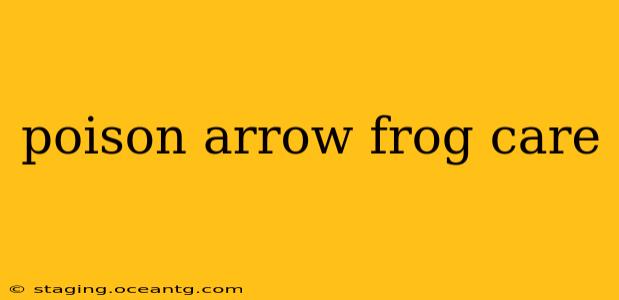The vibrant, jewel-toned poison dart frog captivates many with its stunning beauty. However, before bringing one of these amazing amphibians home, it's crucial to understand the significant commitment involved in their care. This comprehensive guide will equip you with the knowledge necessary to provide a thriving environment for your poison dart frog. This isn't a pet for beginners; responsible ownership requires dedication, research, and a willingness to meet their very specific needs.
What Makes Poison Dart Frog Care So Unique?
Unlike many common pets, poison dart frogs require a highly specific and meticulously maintained environment to thrive. Their natural habitat, the rainforests of Central and South America, necessitates replicating those conditions in captivity. This involves careful attention to temperature, humidity, and diet, all of which will be discussed in detail below. Furthermore, the "poison" in their name is a crucial consideration, although captive-bred frogs are not poisonous. This doesn't negate the need for careful handling and hygiene practices.
What Do Poison Dart Frogs Eat?
What type of food should I feed my poison dart frog? This is a common question among prospective owners. In the wild, their diet consists primarily of insects. In captivity, you'll need to provide a varied diet of appropriately sized insects, such as:
- Fruit flies (Drosophila): A staple food source, offering different sizes depending on the frog's age and size.
- Springtails (Collembola): A great source of protein and a crucial component for a balanced diet.
- Pinhead crickets: Small crickets, ideal for younger frogs.
- Mealworms (Tenebrio molitor): Occasionally offered as a supplementary food, not a primary source.
It's crucial to dust your insects with a calcium and vitamin supplement to ensure your frog receives essential nutrients. Avoid using insecticides or pesticides on the insects.
How Do I Set Up a Poison Dart Frog Vivarium?
How do I create a suitable habitat for my poison dart frog? Creating the proper vivarium is arguably the most important aspect of poison dart frog care. It needs to replicate their natural rainforest environment as closely as possible. This includes:
- Size: The vivarium size depends on the number and species of frogs. Larger is generally better, allowing for more naturalistic plant placement and a more stable environment.
- Substrate: A well-draining substrate, such as a mix of orchid bark, coconut fiber, and leaf litter, is essential. This helps to maintain humidity and provides a natural environment for beneficial microorganisms.
- Humidity: High humidity (70-90%) is crucial. This is achieved through regular misting, a fogger system, or a combination of both.
- Temperature: A warm temperature gradient (75-80°F) is typically ideal, with a slightly cooler area available. Heating pads or heat lamps can help maintain the temperature, but be cautious to avoid overheating.
- Plants: Live plants are essential, providing cover, enrichment, and contributing to humidity. Choose plants that thrive in humid environments, such as bromeliads, orchids, and various ferns. These also contribute greatly to the aesthetics of the vivarium, making it a captivating display.
- Water: A shallow dish of clean water should always be available. The water should be dechlorinated and changed regularly.
What Are the Common Health Problems Faced by Poison Dart Frogs?
What are the common health issues I should be aware of? While relatively hardy when kept in the right conditions, poison dart frogs can suffer from various ailments, including:
- Dehydration: Caused by insufficient humidity.
- Malnutrition: Resulting from an unbalanced diet or inadequate supplementation.
- Bacterial or fungal infections: These can develop in unsanitary conditions.
- Parasites: Regular fecal examinations can help detect and treat parasites early.
Regular observation is key. Any changes in behavior, appetite, or physical appearance should be promptly investigated. Consult a veterinarian experienced with amphibians if you suspect any health issues.
How Often Should I Clean My Poison Dart Frog Vivarium?
How often should I clean the vivarium? Regular maintenance is vital for preventing bacterial and fungal infections. Spot cleaning should be performed daily, removing any uneaten food or waste. A more thorough cleaning, involving substrate changes and a full vivarium cleaning, may be required every few months depending on the size and the number of frogs. Always use dechlorinated water for cleaning.
Breeding Poison Dart Frogs
Can I breed poison dart frogs? Breeding poison dart frogs is challenging and requires advanced knowledge and expertise. It demands creating a meticulously controlled environment with specific parameters regarding humidity, temperature, and food availability. Successful breeding also requires a deep understanding of the frog's specific needs and behavior. It's generally recommended only for experienced keepers.
By following these guidelines, you can create a thriving environment for your poison dart frogs, providing them with the care they deserve. Remember, responsible ownership is a long-term commitment. The rewards of observing these captivating amphibians are immense, but only with diligent care and attention to detail.
